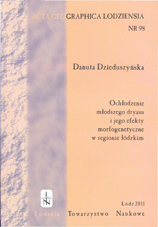Ochłodzenie młodszego dryasu i jego efekty morfogenetyczne w regionie łódzkim
Younger Dryas Cooling and its Morphogenetic Importance in the Łódź Region (Central Poland)
Author(s): Danuta DzieduszyńskaSubject(s): Cultural Essay, Political Essay, Societal Essay
Published by: Łódzkie Towarzystwo Naukowe
Keywords: morphogenetic processes; palaeoenvironment; relief evolution; central Poland
Summary/Abstract: The study concerns the intensity of morphological processes as well as morphological changes during the Younger Dryas in the Łódź Region (central Poland). As the background is shown the present state of knowledge on the last Pleistocene colling episode, especially its causes, climate parameters and chronostratigraphy. Based on the history of vegetation development and geological records, environmental conditions in the Łódź Region during the Younger Dryas have been reconstructed. The mean air temperature of the coldest months decreased up to –20 °C, while the values of the warmest months up to 10 °C, with increasing dryness, considerable aerodynamic activity and at least local permafrost possibile. The conditions favoured an intensification of the morphological processes which is reflected in the variety of geological and morphological proofs and the change of the positive erosional balance into the negative one. Morphological effects of the Younger Dryas cooling have been presented against the previous sta ges of the relief evolution, from the Weichselian Pleniglacial onward, on the basis of landforms and deposits with reliable stratigraphic position. An increased activity has been registered in three sedimentary environments, i.e. slope, fluvial and aeolian ones. The geological effects of the Younger Dryas in the slope sedimentary environment was the series of thinly laminated sands, while the morphologically the changes consisted on the spatial extention of the valley areas. In the fluvial environment, the Younger Dryas period was marked by an enhanced activity, expressed mosty as in the presence of all river channel patterns. Locally the low terrace was formed. In the aeolian environment, besides the dune transformation processes, aeolian covers may have been deposited. Apart from a considerable dynamics of the environment, a spatial diversity of the processes as a result of the different hypsometrical conditions and the stage of the landform evolution. The analyses gave not clear answer to the question about the nature (local or global) of the differences.
Journal: Acta Geographica Lodziensia
- Issue Year: 2011
- Issue No: 098
- Page Range: 1-101
- Page Count: 101
- Language: Polish

